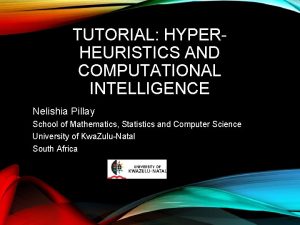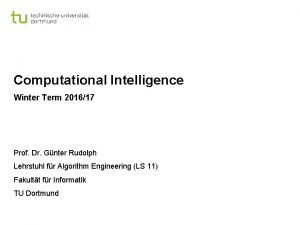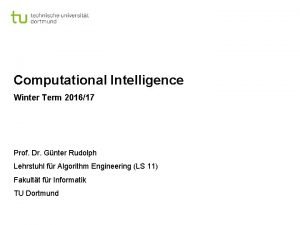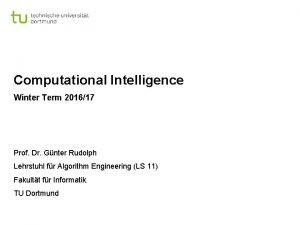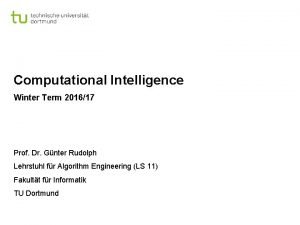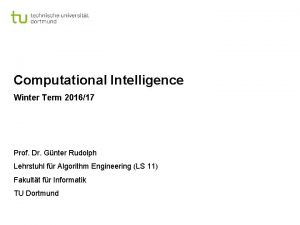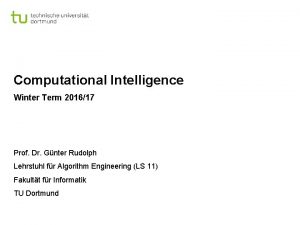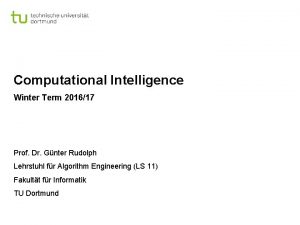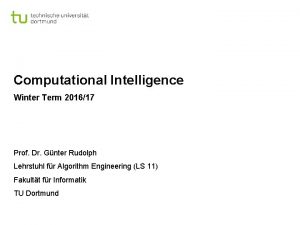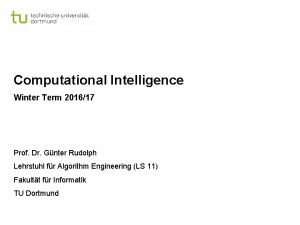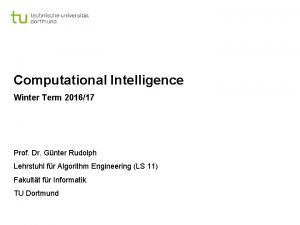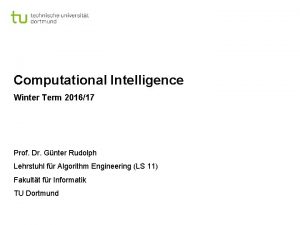Computational Intelligence Winter Term 201617 Prof Dr Gnter
















- Slides: 16

Computational Intelligence Winter Term 2016/17 Prof. Dr. Günter Rudolph Lehrstuhl für Algorithm Engineering (LS 11) Fakultät für Informatik TU Dortmund

Plan for Today Lecture 04 ● Bidirectional Associative Memory (BAM) § Fixed Points § Concept of Energy Function § Stable States = Minimizers of Energy Function ● Hopfield Network § Convergence § Application to Combinatorial Optimization G. Rudolph: Computational Intelligence ▪ Winter Term 2016/17 2

Bidirectional Associative Memory (BAM) Lecture 04 Network Model w 11 x 1 y 1 • fully connected x 2 y 2 • bidirectional edges x 3 y 3 • synchonized: wnk . . . xn step t : data flow from x to y step t + 1 : data flow from y to x yk start: y(0) = sgn(x(0) W) x, y : row vectors x(1) = sgn(y(0) W‘) W : weight matrix y(1) = sgn(x(1) W) W‘ : transpose of W x(2) = sgn(y(1) W‘) bipolar inputs {-1, +1} . . . G. Rudolph: Computational Intelligence ▪ Winter Term 2016/17 3

Bidirectional Associative Memory (BAM) Lecture 04 Fixed Points Definition (x, y) is fixed point of BAM iff y = sgn(x W) and x‘ = sgn(W y‘). Set W = x‘ y. □ (note: x is row vector) y = sgn( x W ) = sgn( x (x‘ y) ) = sgn( (x x‘) y) = sgn( || x ||2 y) = y > 0 (does not alter sign) x‘ = sgn( W y‘) = sgn( (x‘y) y‘ ) = sgn( x‘ (y y‘) ) = sgn( x‘ || y ||2 ) = x‘ > 0 (does not alter sign) Theorem: If W = x‘y then (x, y) is fixed point of BAM. □ G. Rudolph: Computational Intelligence ▪ Winter Term 2016/17 4

Bidirectional Associative Memory (BAM) Lecture 04 Concept of Energy Function given: BAM with W = x‘y starting point x(0) (x, y) is stable state of BAM y(0) = sgn( x(0) W ) excitation e‘ = W (y(0))‘ if sign( e‘ ) = x(0) then ( x(0) , y(0) ) stable state small angle between e‘ and x(0) true if e‘ close to x(0) 1 x(0) = (1, 1) 0 1 1 small angle large cos( ) recall: 0 G. Rudolph: Computational Intelligence ▪ Winter Term 2016/17 5

Bidirectional Associative Memory (BAM) Lecture 04 Concept of Energy Function required: small angle between e‘ = W y(0) ‘ and x(0) larger cosine of angle indicates greater similarity of vectors e‘ of equal size: try to maximize x(0) e‘ = || x(0) || ¢ || e || ¢ cos Å (x(0) , e) fixed → max! maximize x(0) e‘ = x(0) W y(0) ‘ identical to minimize -x(0) W y(0) ‘ Definition Energy function of BAM at iteration t is E( x(t) , y(t) ) = – 1 – 2 x(t) W y(t) ‘ □ G. Rudolph: Computational Intelligence ▪ Winter Term 2016/17 6

Bidirectional Associative Memory (BAM) Lecture 04 Stable States Theorem An asynchronous BAM with arbitrary weight matrix W reaches steady state in a finite number of updates. Proof: excitations BAM asynchronous select neuron at random from left or right layer, compute its excitation and change state if necessary (states of other neurons not affected) G. Rudolph: Computational Intelligence ▪ Winter Term 2016/17 7

Bidirectional Associative Memory (BAM) neuron i of left layer has changed Lecture 04 sgn(xi) ≠ sgn(bi) xi was updated to ~xi = –xi xi bi xi - ~ xi -1 >0 <0 +1 <0 >0 <0 use analogous argumentation if neuron of right layer has changed every update (change of state) decreases energy function since number of different bipolar vectors is finite update stops after finite #updates remark: dynamics of BAM get stable in local minimum of energy function! q. e. d. G. Rudolph: Computational Intelligence ▪ Winter Term 2016/17 8

Hopfield Network Lecture 04 special case of BAM but proposed earlier (1982) 1 characterization: • neurons preserve state until selected at random for update 2 3 • n neurons fully connected • symmetric weight matrix 1 • no self-loops (→ zero main diagonal entries) 2 • thresholds , neuron i fires if excitations larger than i 3 transition: select index k at random, new state is where energy of state x is G. Rudolph: Computational Intelligence ▪ Winter Term 2016/17 9

Hopfield Network Lecture 04 Theorem: Hopfield network converges to local minimum of energy function after a finite number of updates. □ Proof: assume that xk has been updated = 0 if i ≠ k G. Rudolph: Computational Intelligence ▪ Winter Term 2016/17 10

Hopfield Network Lecture 04 = 0 if j ≠ k (rename j to i, recall W = W‘, wkk = 0) >0 since: excitation ek > 0 if xk < 0 and vice versa q. e. d. G. Rudolph: Computational Intelligence ▪ Winter Term 2016/17 11

Hopfield Network Lecture 04 Application to Combinatorial Optimization Idea: • transform combinatorial optimization problem as objective function with x {-1, +1}n • rearrange objective function to look like a Hopfield energy function • extract weights W and thresholds from this energy function • initialize a Hopfield net with these parameters W and • run the Hopfield net until reaching stable state (= local minimizer of energy function) • stable state is local minimizer of combinatorial optimization problem G. Rudolph: Computational Intelligence ▪ Winter Term 2016/17 12

Hopfield Network Lecture 04 Example I: Linear Functions Evidently: fixed point reached after (n log n) iterations on average [ proof: → black board ] G. Rudolph: Computational Intelligence ▪ Winter Term 2016/17 13

Hopfield Network Lecture 04 Example II: MAXCUT given: graph with n nodes and symmetric weights ij = ji , ii = 0, on edges task: find a partition V = (V 0, V 1) of the nodes such that the weighted sum of edges with one endpoint in V 0 and one endpoint in V 1 becomes maximal encoding: i=1, . . . , n: yi = 0 , node i in set V 0; yi = 1 , node i in set V 1 objective function: preparations for applying Hopfield network step 1: conversion to minimization problem step 2: transformation of variables step 3: transformation to “Hopfield normal form“ step 4: extract coefficients as weights and thresholds of Hopfield net G. Rudolph: Computational Intelligence ▪ Winter Term 2016/17 14

Hopfield Network Lecture 04 Example II: MAXCUT (continued) step 1: conversion to minimization problem multiply function with -1 E(y) = -f(y) → min! step 2: transformation of variables yi = (xi+1) / 2 constant value (does not affect location of optimal solution) G. Rudolph: Computational Intelligence ▪ Winter Term 2016/17 15

Hopfield Network Lecture 04 Example II: MAXCUT (continued) step 3: transformation to “Hopfield normal form“ wij 0‘ step 4: extract coefficients as weights and thresholds of Hopfield net remark: G. Rudolph: Computational Intelligence ▪ Winter Term 2016/17 16
 Computational intelligence tutorial
Computational intelligence tutorial Percept sentence
Percept sentence Es ist kalt es ist kalt flocken fallen nieder
Es ist kalt es ist kalt flocken fallen nieder Winter kommt winter kommt flocken fallen nieder
Winter kommt winter kommt flocken fallen nieder Winter kommt flocken fallen nieder
Winter kommt flocken fallen nieder Professor arthur winter
Professor arthur winter Those winter sundays poetry prof
Those winter sundays poetry prof Rules in finding the nth term
Rules in finding the nth term In my understanding
In my understanding Term to term rule
Term to term rule Term to term rule
Term to term rule Long term memory vs short term memory
Long term memory vs short term memory Difference between long term and short term liabilities
Difference between long term and short term liabilities Short term goal
Short term goal Site:slidetodoc.com
Site:slidetodoc.com Maxterm expansion
Maxterm expansion Accounting for serial bonds
Accounting for serial bonds
